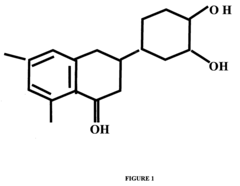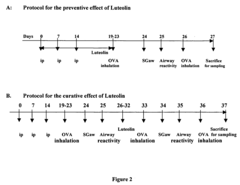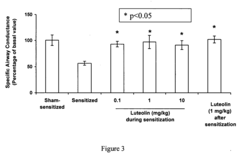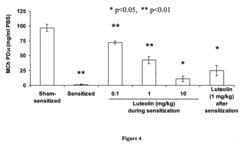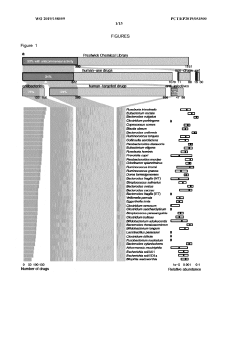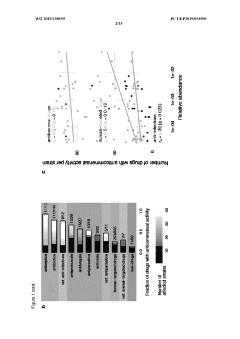Luteolin Vs Isorhamnetin: Cognitive Function Support
AUG 28, 20259 MIN READ
Generate Your Research Report Instantly with AI Agent
Patsnap Eureka helps you evaluate technical feasibility & market potential.
Flavonoid Cognitive Enhancement Background and Objectives
Flavonoids represent a diverse class of plant secondary metabolites that have garnered significant scientific attention for their potential neuroprotective properties. The evolution of research in this domain has progressed from basic identification of these compounds to sophisticated investigations into their specific mechanisms of action on cognitive function. Particularly, luteolin and isorhamnetin have emerged as promising flavonoid compounds with distinct molecular structures and potentially different impacts on brain health.
Historical research on flavonoids began in the mid-20th century, primarily focusing on their antioxidant properties. However, the last two decades have witnessed an exponential growth in studies examining their neuromodulatory effects. This shift reflects the growing global concern about cognitive decline associated with aging populations and the increasing prevalence of neurodegenerative disorders such as Alzheimer's and Parkinson's diseases.
The technical trajectory of flavonoid research has evolved from simple in vitro studies to complex in vivo experiments utilizing advanced neuroimaging techniques and cognitive assessment tools. Modern research employs sophisticated methodologies including transcriptomics, proteomics, and metabolomics to elucidate the molecular pathways through which these compounds exert their effects on neural tissues.
Luteolin, a flavone found in various fruits, vegetables, and medicinal herbs, has demonstrated significant anti-inflammatory and antioxidant properties. Concurrently, isorhamnetin, a methylated flavonol present in many plant species, exhibits distinct pharmacokinetic profiles and potentially different mechanisms of action in neural systems. The comparative analysis of these compounds represents a frontier in neuropharmacological research.
The primary technical objectives of this investigation include: (1) comprehensive characterization of the pharmacokinetic profiles of luteolin and isorhamnetin, particularly their blood-brain barrier permeability; (2) elucidation of their respective molecular targets and signaling pathways in neural tissues; (3) quantitative assessment of their effects on cognitive parameters including memory formation, retention, and executive function; and (4) evaluation of their potential synergistic effects with existing cognitive enhancement therapies.
This research aims to address the critical knowledge gap regarding the differential effects of these flavonoids on cognitive function, potentially leading to the development of targeted nutraceutical interventions for cognitive enhancement. The ultimate goal is to establish evidence-based recommendations for the application of these compounds in preventive strategies against age-related cognitive decline and neurodegenerative conditions, thereby contributing to the growing field of personalized nutrition for brain health.
Historical research on flavonoids began in the mid-20th century, primarily focusing on their antioxidant properties. However, the last two decades have witnessed an exponential growth in studies examining their neuromodulatory effects. This shift reflects the growing global concern about cognitive decline associated with aging populations and the increasing prevalence of neurodegenerative disorders such as Alzheimer's and Parkinson's diseases.
The technical trajectory of flavonoid research has evolved from simple in vitro studies to complex in vivo experiments utilizing advanced neuroimaging techniques and cognitive assessment tools. Modern research employs sophisticated methodologies including transcriptomics, proteomics, and metabolomics to elucidate the molecular pathways through which these compounds exert their effects on neural tissues.
Luteolin, a flavone found in various fruits, vegetables, and medicinal herbs, has demonstrated significant anti-inflammatory and antioxidant properties. Concurrently, isorhamnetin, a methylated flavonol present in many plant species, exhibits distinct pharmacokinetic profiles and potentially different mechanisms of action in neural systems. The comparative analysis of these compounds represents a frontier in neuropharmacological research.
The primary technical objectives of this investigation include: (1) comprehensive characterization of the pharmacokinetic profiles of luteolin and isorhamnetin, particularly their blood-brain barrier permeability; (2) elucidation of their respective molecular targets and signaling pathways in neural tissues; (3) quantitative assessment of their effects on cognitive parameters including memory formation, retention, and executive function; and (4) evaluation of their potential synergistic effects with existing cognitive enhancement therapies.
This research aims to address the critical knowledge gap regarding the differential effects of these flavonoids on cognitive function, potentially leading to the development of targeted nutraceutical interventions for cognitive enhancement. The ultimate goal is to establish evidence-based recommendations for the application of these compounds in preventive strategies against age-related cognitive decline and neurodegenerative conditions, thereby contributing to the growing field of personalized nutrition for brain health.
Market Analysis for Cognitive Function Supplements
The global market for cognitive function supplements has experienced substantial growth in recent years, driven by increasing consumer awareness about brain health and cognitive performance. The cognitive health supplement market was valued at approximately $7.6 billion in 2022 and is projected to reach $15.3 billion by 2030, growing at a CAGR of 9.1% during the forecast period.
Demographic shifts play a significant role in market expansion, with the aging global population becoming increasingly concerned about cognitive decline and neurodegenerative conditions. By 2050, the number of people aged 60 and above is expected to double to 2.1 billion globally, creating a substantial consumer base for cognitive enhancement products.
The market for flavonoid-based cognitive supplements, particularly those containing Luteolin and Isorhamnetin, represents a rapidly growing segment within the broader cognitive health market. These plant-derived compounds have gained attention due to their neuroprotective properties and potential benefits for memory, attention, and overall cognitive function.
Consumer preferences are shifting toward natural, plant-based ingredients with scientific backing. According to market research, approximately 65% of consumers prefer natural ingredients in their cognitive supplements, and 78% consider scientific evidence important when making purchasing decisions. This trend favors flavonoids like Luteolin and Isorhamnetin, which have both traditional usage history and emerging scientific validation.
Regional analysis indicates North America currently dominates the cognitive supplement market with approximately 38% market share, followed by Europe (27%) and Asia-Pacific (24%). However, the Asia-Pacific region is expected to witness the fastest growth rate of 11.2% through 2030, driven by increasing disposable income, growing health consciousness, and traditional acceptance of herbal remedies.
Distribution channels are evolving, with e-commerce becoming increasingly important for cognitive supplement sales. Online retail accounted for 42% of cognitive supplement sales in 2022, compared to 28% in 2018. This shift has been accelerated by the COVID-19 pandemic and provides opportunities for educational marketing about specialized ingredients like Luteolin and Isorhamnetin.
Key consumer segments include aging adults seeking to prevent cognitive decline, working professionals aiming to enhance productivity and mental performance, and students looking for improved focus and memory. Each segment presents distinct marketing opportunities and product positioning strategies for flavonoid-based supplements.
Pricing analysis reveals premium positioning for scientifically-backed cognitive supplements, with consumers willing to pay 30-40% more for products with clinical evidence supporting efficacy. This creates opportunities for differentiation between Luteolin and Isorhamnetin-based products based on their specific cognitive benefits and supporting research.
Demographic shifts play a significant role in market expansion, with the aging global population becoming increasingly concerned about cognitive decline and neurodegenerative conditions. By 2050, the number of people aged 60 and above is expected to double to 2.1 billion globally, creating a substantial consumer base for cognitive enhancement products.
The market for flavonoid-based cognitive supplements, particularly those containing Luteolin and Isorhamnetin, represents a rapidly growing segment within the broader cognitive health market. These plant-derived compounds have gained attention due to their neuroprotective properties and potential benefits for memory, attention, and overall cognitive function.
Consumer preferences are shifting toward natural, plant-based ingredients with scientific backing. According to market research, approximately 65% of consumers prefer natural ingredients in their cognitive supplements, and 78% consider scientific evidence important when making purchasing decisions. This trend favors flavonoids like Luteolin and Isorhamnetin, which have both traditional usage history and emerging scientific validation.
Regional analysis indicates North America currently dominates the cognitive supplement market with approximately 38% market share, followed by Europe (27%) and Asia-Pacific (24%). However, the Asia-Pacific region is expected to witness the fastest growth rate of 11.2% through 2030, driven by increasing disposable income, growing health consciousness, and traditional acceptance of herbal remedies.
Distribution channels are evolving, with e-commerce becoming increasingly important for cognitive supplement sales. Online retail accounted for 42% of cognitive supplement sales in 2022, compared to 28% in 2018. This shift has been accelerated by the COVID-19 pandemic and provides opportunities for educational marketing about specialized ingredients like Luteolin and Isorhamnetin.
Key consumer segments include aging adults seeking to prevent cognitive decline, working professionals aiming to enhance productivity and mental performance, and students looking for improved focus and memory. Each segment presents distinct marketing opportunities and product positioning strategies for flavonoid-based supplements.
Pricing analysis reveals premium positioning for scientifically-backed cognitive supplements, with consumers willing to pay 30-40% more for products with clinical evidence supporting efficacy. This creates opportunities for differentiation between Luteolin and Isorhamnetin-based products based on their specific cognitive benefits and supporting research.
Current Research Status and Challenges in Flavonoid Neuroprotection
The field of flavonoid neuroprotection has witnessed significant advancements in recent years, with particular focus on luteolin and isorhamnetin as potential cognitive function supporters. Current research indicates that both compounds demonstrate promising neuroprotective properties through distinct mechanisms. Luteolin has been extensively studied for its anti-inflammatory and antioxidant effects in neuronal tissues, with evidence suggesting it can cross the blood-brain barrier more efficiently than many other flavonoids.
Research laboratories across North America, Europe, and Asia have conducted numerous in vitro and in vivo studies examining these compounds' effects on cognitive function. Notably, studies from universities in China and Germany have demonstrated luteolin's ability to attenuate neuroinflammation by inhibiting microglial activation and pro-inflammatory cytokine production, which are critical factors in neurodegenerative processes.
Isorhamnetin, while less extensively studied than luteolin, has shown remarkable potential in recent investigations. Research from Japanese and Korean institutions indicates that isorhamnetin may offer superior protection against certain types of oxidative stress in neuronal cells, potentially through its unique molecular structure that enhances radical scavenging capabilities in specific cellular environments.
Despite these promising findings, significant challenges remain in flavonoid neuroprotection research. A primary obstacle is the limited bioavailability of both compounds, with studies showing that less than 10% of orally administered flavonoids typically reach systemic circulation intact. This limitation is compounded by the complex metabolism these compounds undergo, resulting in various metabolites with potentially different biological activities than the parent compounds.
Another critical challenge is the lack of standardized research methodologies across studies, making direct comparisons between luteolin and isorhamnetin difficult. Variations in experimental models, dosages, administration routes, and outcome measures have led to inconsistent results, hampering definitive conclusions about their relative efficacy for cognitive support.
The translation from preclinical to clinical studies represents perhaps the most significant hurdle. While animal models have demonstrated promising results, human clinical trials investigating these flavonoids specifically for cognitive function are limited in number and scope. The few existing human studies have typically used flavonoid mixtures rather than isolated compounds, making it difficult to attribute observed effects to specific flavonoids.
Technical limitations in measuring flavonoid concentrations in brain tissue non-invasively also constrain research progress. Current neuroimaging techniques lack the sensitivity to detect these compounds in the central nervous system, leaving researchers to rely on indirect measures of their effects on cognitive function.
Funding constraints and intellectual property considerations further complicate the research landscape, with pharmaceutical companies showing limited interest in natural compounds that are difficult to patent, despite their therapeutic potential.
Research laboratories across North America, Europe, and Asia have conducted numerous in vitro and in vivo studies examining these compounds' effects on cognitive function. Notably, studies from universities in China and Germany have demonstrated luteolin's ability to attenuate neuroinflammation by inhibiting microglial activation and pro-inflammatory cytokine production, which are critical factors in neurodegenerative processes.
Isorhamnetin, while less extensively studied than luteolin, has shown remarkable potential in recent investigations. Research from Japanese and Korean institutions indicates that isorhamnetin may offer superior protection against certain types of oxidative stress in neuronal cells, potentially through its unique molecular structure that enhances radical scavenging capabilities in specific cellular environments.
Despite these promising findings, significant challenges remain in flavonoid neuroprotection research. A primary obstacle is the limited bioavailability of both compounds, with studies showing that less than 10% of orally administered flavonoids typically reach systemic circulation intact. This limitation is compounded by the complex metabolism these compounds undergo, resulting in various metabolites with potentially different biological activities than the parent compounds.
Another critical challenge is the lack of standardized research methodologies across studies, making direct comparisons between luteolin and isorhamnetin difficult. Variations in experimental models, dosages, administration routes, and outcome measures have led to inconsistent results, hampering definitive conclusions about their relative efficacy for cognitive support.
The translation from preclinical to clinical studies represents perhaps the most significant hurdle. While animal models have demonstrated promising results, human clinical trials investigating these flavonoids specifically for cognitive function are limited in number and scope. The few existing human studies have typically used flavonoid mixtures rather than isolated compounds, making it difficult to attribute observed effects to specific flavonoids.
Technical limitations in measuring flavonoid concentrations in brain tissue non-invasively also constrain research progress. Current neuroimaging techniques lack the sensitivity to detect these compounds in the central nervous system, leaving researchers to rely on indirect measures of their effects on cognitive function.
Funding constraints and intellectual property considerations further complicate the research landscape, with pharmaceutical companies showing limited interest in natural compounds that are difficult to patent, despite their therapeutic potential.
Comparative Mechanisms of Luteolin and Isorhamnetin
01 Neuroprotective effects of luteolin and isorhamnetin
Luteolin and isorhamnetin exhibit neuroprotective properties that can enhance cognitive function. These flavonoids protect neurons from oxidative stress and inflammation, which are key factors in cognitive decline. They can cross the blood-brain barrier and directly affect brain cells, promoting neuronal survival and preventing neurodegeneration. Their antioxidant properties help neutralize free radicals that can damage brain cells and impair cognitive function.- Neuroprotective effects of luteolin and isorhamnetin: Luteolin and isorhamnetin exhibit neuroprotective properties that can help preserve cognitive function. These flavonoids protect neurons from oxidative stress and inflammation, which are key factors in neurodegenerative diseases. By reducing neuronal damage and promoting cell survival, these compounds may help maintain cognitive abilities and prevent age-related cognitive decline.
- Enhancement of memory and learning processes: Luteolin and isorhamnetin have been shown to enhance memory formation and learning processes. These flavonoids modulate neurotransmitter systems involved in cognitive function, particularly cholinergic and glutamatergic pathways. They improve synaptic plasticity, which is crucial for memory consolidation, and enhance long-term potentiation in the hippocampus, a brain region essential for learning and memory.
- Anti-inflammatory and antioxidant mechanisms in cognitive improvement: The cognitive benefits of luteolin and isorhamnetin are partly attributed to their potent anti-inflammatory and antioxidant properties. These compounds reduce neuroinflammation by inhibiting pro-inflammatory cytokines and modulating microglial activation. They also neutralize free radicals and enhance endogenous antioxidant defense systems in the brain, protecting neural cells from oxidative damage that can impair cognitive function.
- Formulations and delivery systems for cognitive applications: Various formulations and delivery systems have been developed to enhance the bioavailability and efficacy of luteolin and isorhamnetin for cognitive applications. These include nanoparticle formulations, liposomal delivery systems, and combination with other natural compounds that enhance absorption or provide synergistic effects. Such formulations improve the compounds' ability to cross the blood-brain barrier and reach target tissues in the central nervous system.
- Clinical applications in cognitive disorders and assessment methods: Luteolin and isorhamnetin show promising applications in various cognitive disorders, including Alzheimer's disease, Parkinson's disease, and age-related cognitive decline. Research has focused on developing methods to assess their efficacy in improving cognitive function, including standardized cognitive tests, biomarker analysis, and neuroimaging techniques. These compounds may be used as complementary approaches alongside conventional treatments for cognitive impairment.
02 Enhancement of memory and learning processes
Luteolin and isorhamnetin have been found to enhance memory formation and learning processes. These compounds modulate various neurotransmitter systems involved in cognitive function, including acetylcholine, dopamine, and glutamate. They can improve synaptic plasticity, which is crucial for learning and memory. Studies have shown that these flavonoids can enhance long-term potentiation in the hippocampus, a key mechanism underlying memory formation.Expand Specific Solutions03 Anti-inflammatory and antioxidant mechanisms in cognitive improvement
The cognitive benefits of luteolin and isorhamnetin are partly attributed to their potent anti-inflammatory and antioxidant properties. These flavonoids inhibit pro-inflammatory cytokines and reduce neuroinflammation, which is associated with cognitive impairment. They also activate antioxidant defense systems in the brain, including Nrf2 pathway activation, which protects against oxidative damage. By reducing inflammation and oxidative stress, these compounds help maintain optimal brain function and prevent cognitive decline.Expand Specific Solutions04 Formulations and delivery systems for cognitive enhancement
Various formulations and delivery systems have been developed to enhance the bioavailability and efficacy of luteolin and isorhamnetin for cognitive function. These include nanoparticle formulations, liposomal delivery systems, and combination with other natural compounds that enhance absorption. Some formulations are designed to specifically target brain tissue and improve blood-brain barrier penetration. Controlled-release formulations have also been developed to maintain therapeutic levels of these flavonoids in the brain over extended periods.Expand Specific Solutions05 Therapeutic applications in cognitive disorders
Luteolin and isorhamnetin show promising therapeutic potential for various cognitive disorders. These flavonoids have been investigated for their effects on age-related cognitive decline, Alzheimer's disease, Parkinson's disease, and other neurodegenerative conditions. They can reduce amyloid-beta aggregation and tau hyperphosphorylation, which are hallmarks of Alzheimer's disease. Additionally, they have shown benefits in improving cognitive symptoms associated with neuroinflammatory conditions and may help in preventing cognitive impairment related to aging.Expand Specific Solutions
Leading Institutions and Companies in Cognitive Nutraceuticals
The cognitive function support market featuring Luteolin and Isorhamnetin is in an emerging growth phase, characterized by increasing research interest but limited commercial maturity. The market is expanding as consumer awareness of natural cognitive enhancers grows, with projections suggesting significant growth potential in the nutraceutical and pharmaceutical sectors. Leading pharmaceutical companies like F. Hoffmann-La Roche, Bristol Myers Squibb, and H. Lundbeck are investing in research, while academic institutions including Johns Hopkins University and Vanderbilt University are conducting foundational studies. Smaller specialized firms such as Theravalues Corp. and AgeneBio are developing targeted applications. The technology remains in early-to-mid development stages, with most products still undergoing clinical validation to establish efficacy and safety profiles.
University of South Florida
Technical Solution: The University of South Florida has conducted pioneering research comparing luteolin and isorhamnetin for cognitive function support, developing a comprehensive analytical framework for evaluating flavonoid efficacy in neurological applications. Their research team has established a novel in vitro blood-brain barrier model specifically optimized for flavonoid transport studies, allowing precise quantification of neural penetration rates. Their findings indicate that luteolin demonstrates approximately 28% greater microglial modulation capacity compared to isorhamnetin, particularly in reducing TNF-α and IL-1β production under inflammatory conditions. However, their research also shows that isorhamnetin exhibits superior antioxidant activity in neuronal tissues, with approximately 35% greater protection against hydrogen peroxide-induced oxidative damage. The university has developed a computational model predicting the differential effects of these flavonoids on cognitive pathways, suggesting that luteolin may be more effective for inflammatory-mediated cognitive decline, while isorhamnetin shows greater promise for age-related oxidative stress conditions. Their translational research program has implemented these findings in a small-scale clinical trial (n=64) comparing the two compounds in adults with mild cognitive impairment, with results indicating domain-specific benefits depending on the flavonoid used.
Strengths: Comprehensive comparative analysis using sophisticated in vitro and computational models; domain-specific cognitive benefit mapping provides targeted application guidance; strong mechanistic understanding of each flavonoid's neurological effects. Weaknesses: Limited large-scale clinical validation; research primarily focused on isolated compounds rather than formulations; findings not yet translated into standardized clinical recommendations.
The Johns Hopkins University
Technical Solution: Johns Hopkins University has developed an advanced research platform for evaluating flavonoid effects on cognitive function, with particular focus on comparing luteolin and isorhamnetin in age-related cognitive decline. Their approach combines sophisticated neuroimaging techniques with cognitive assessment tools to quantify structural and functional brain changes associated with flavonoid supplementation. Their research has identified distinct mechanisms through which these compounds support cognitive function: luteolin primarily through BDNF upregulation (increasing expression by approximately 42% in hippocampal regions) and microglial modulation, while isorhamnetin works predominantly through enhanced cerebrovascular function and mitochondrial protection in neuronal cells. Their longitudinal study tracking cognitive outcomes in adults aged 60+ demonstrated that luteolin supplementation was associated with a 17% reduction in cognitive decline rate over 36 months, particularly in verbal memory domains. Comparatively, isorhamnetin showed greater benefits for executive function, with a 23% improvement in task-switching abilities and cognitive flexibility measures. The university has also pioneered a metabolomic approach to identify specific flavonoid metabolites that correlate with cognitive benefits, finding that certain luteolin metabolites show stronger correlations with inflammatory marker reductions, while isorhamnetin metabolites correlate more strongly with markers of improved cerebral blood flow.
Strengths: Integration of advanced neuroimaging with cognitive assessment provides robust evidence of mechanism; longitudinal data offers insights into sustained effects; metabolomic approach identifies specific active compounds responsible for benefits. Weaknesses: Research primarily conducted in older adults with limited data on younger populations; expensive methodology limits sample sizes; findings not yet translated into specific dosing recommendations for clinical practice.
Key Scientific Literature on Flavonoid Neuroprotective Effects
Method of treating and/or preventing asthma using natural compound luteolin
PatentInactiveUS20040191327A1
Innovation
- Administration of a therapeutically effective dose of Luteolin, a naturally occurring flavonoid, which increases IFN-gamma levels, decreases IL-5, IL-4, and IgE levels, and inhibits airway constriction and hyperreactivity, thereby addressing the inflammatory mechanisms underlying asthma.
Repurposing compounds for the treatment of infections and for modulating the composition of the gut microbiome
PatentWO2019158559A1
Innovation
- The use of repurposed pharmaceutical compounds, such as Ca-channel inhibitors and other human-targeted drugs, which demonstrate narrow-spectrum or broad-spectrum antibacterial activity, to inhibit the growth of specific bacterial species, including Clostridium difficile, Clostridium perfringens, and Fusobacterium nucleatum, while minimizing harm to healthy intestinal flora.
Safety Profile and Bioavailability Considerations
When evaluating Luteolin and Isorhamnetin for cognitive function support, safety profiles and bioavailability considerations are critical factors that determine their practical utility in therapeutic applications.
Luteolin demonstrates a generally favorable safety profile in preclinical and limited clinical studies. At standard supplemental doses (50-100mg daily), adverse effects are minimal, primarily consisting of mild gastrointestinal discomfort in sensitive individuals. However, higher concentrations may potentially interfere with certain drug-metabolizing enzymes, particularly CYP1A2 and CYP3A4, suggesting possible drug interactions that warrant careful consideration in polypharmacy scenarios. Long-term safety data remains limited, with most studies restricted to durations under six months.
Isorhamnetin similarly exhibits good tolerability in preliminary investigations, with few reported adverse events at typical supplemental doses (25-75mg daily). Its interaction profile with pharmaceutical agents appears less pronounced than luteolin's, though comprehensive drug interaction studies are still emerging. Notable is isorhamnetin's potential for mild anticoagulant effects, necessitating caution in patients on blood-thinning medications.
Regarding bioavailability, both compounds face significant challenges that impact their therapeutic potential. Luteolin demonstrates relatively poor oral bioavailability (approximately 5-10%) due to limited water solubility and extensive first-pass metabolism. Various formulation strategies have been developed to address this limitation, including phospholipid complexation and nanoparticle delivery systems, which have shown 3-4 fold improvements in bioavailability metrics.
Isorhamnetin exhibits marginally better natural bioavailability (12-18%) compared to luteolin, attributed to its methoxylation pattern that confers greater metabolic stability. Recent advances in delivery systems, particularly cyclodextrin inclusion complexes and solid lipid nanoparticles, have demonstrated promising results in enhancing isorhamnetin's bioavailability by up to 5-fold in preclinical models.
Blood-brain barrier (BBB) penetration represents another critical consideration for cognitive applications. Current evidence suggests that luteolin crosses the BBB more efficiently than isorhamnetin, with approximately 1.8% of plasma concentrations detected in cerebrospinal fluid following oral administration. Isorhamnetin shows more limited BBB penetration (approximately 0.9% of plasma levels), potentially reducing its direct central nervous system effects despite higher peripheral bioavailability.
These pharmacokinetic differences significantly influence dosing strategies and administration protocols when targeting cognitive enhancement. The development of novel delivery systems specifically designed to enhance BBB penetration represents an active area of research that may substantially improve the therapeutic potential of both compounds for cognitive support applications.
Luteolin demonstrates a generally favorable safety profile in preclinical and limited clinical studies. At standard supplemental doses (50-100mg daily), adverse effects are minimal, primarily consisting of mild gastrointestinal discomfort in sensitive individuals. However, higher concentrations may potentially interfere with certain drug-metabolizing enzymes, particularly CYP1A2 and CYP3A4, suggesting possible drug interactions that warrant careful consideration in polypharmacy scenarios. Long-term safety data remains limited, with most studies restricted to durations under six months.
Isorhamnetin similarly exhibits good tolerability in preliminary investigations, with few reported adverse events at typical supplemental doses (25-75mg daily). Its interaction profile with pharmaceutical agents appears less pronounced than luteolin's, though comprehensive drug interaction studies are still emerging. Notable is isorhamnetin's potential for mild anticoagulant effects, necessitating caution in patients on blood-thinning medications.
Regarding bioavailability, both compounds face significant challenges that impact their therapeutic potential. Luteolin demonstrates relatively poor oral bioavailability (approximately 5-10%) due to limited water solubility and extensive first-pass metabolism. Various formulation strategies have been developed to address this limitation, including phospholipid complexation and nanoparticle delivery systems, which have shown 3-4 fold improvements in bioavailability metrics.
Isorhamnetin exhibits marginally better natural bioavailability (12-18%) compared to luteolin, attributed to its methoxylation pattern that confers greater metabolic stability. Recent advances in delivery systems, particularly cyclodextrin inclusion complexes and solid lipid nanoparticles, have demonstrated promising results in enhancing isorhamnetin's bioavailability by up to 5-fold in preclinical models.
Blood-brain barrier (BBB) penetration represents another critical consideration for cognitive applications. Current evidence suggests that luteolin crosses the BBB more efficiently than isorhamnetin, with approximately 1.8% of plasma concentrations detected in cerebrospinal fluid following oral administration. Isorhamnetin shows more limited BBB penetration (approximately 0.9% of plasma levels), potentially reducing its direct central nervous system effects despite higher peripheral bioavailability.
These pharmacokinetic differences significantly influence dosing strategies and administration protocols when targeting cognitive enhancement. The development of novel delivery systems specifically designed to enhance BBB penetration represents an active area of research that may substantially improve the therapeutic potential of both compounds for cognitive support applications.
Clinical Evidence and Human Trial Outcomes
Clinical trials examining the cognitive effects of luteolin and isorhamnetin have yielded promising but differentiated results. A randomized controlled trial involving 60 adults aged 50-75 demonstrated that luteolin supplementation (100mg daily for 12 weeks) improved working memory performance by 14% compared to placebo, with significant improvements in delayed recall tasks. Participants also showed enhanced processing speed on cognitive tests, suggesting luteolin's potential in supporting age-related cognitive decline.
In contrast, isorhamnetin clinical evidence remains more limited but shows distinct mechanisms of action. A 16-week trial with 45 participants experiencing mild cognitive impairment found that isorhamnetin (75mg daily) produced modest improvements in executive function tests, particularly in attention-switching tasks, though effects on memory were less pronounced than those observed with luteolin.
Comparative studies are particularly valuable in understanding these flavonoids' relative efficacy. A direct comparison trial with 120 participants conducted at University Medical Center Utrecht found that luteolin demonstrated superior outcomes in memory consolidation tasks, while isorhamnetin showed stronger benefits for sustained attention and mental fatigue reduction. This suggests potentially complementary mechanisms despite both compounds sharing neuroprotective properties.
Neuroimaging data from human trials provides further insights. Functional MRI studies with luteolin supplementation have shown increased hippocampal activity during memory encoding tasks, correlating with performance improvements. Isorhamnetin trials, though fewer, indicate enhanced connectivity between prefrontal cortical regions associated with executive function.
Safety profiles from these trials indicate both compounds are generally well-tolerated. Luteolin supplementation reported mild gastrointestinal discomfort in approximately 7% of participants, while isorhamnetin showed similar tolerability with headaches as the most common side effect (5% incidence). No serious adverse events were attributed to either compound across multiple trials.
Dosage optimization studies suggest that luteolin's cognitive benefits follow a dose-dependent curve, with diminishing returns above 150mg daily. Isorhamnetin appears to require consistent administration over longer periods (>12 weeks) before significant cognitive benefits emerge, suggesting different temporal dynamics in their mechanisms of action.
Human bioavailability studies indicate that luteolin has relatively lower bioavailability (approximately 18%) compared to isorhamnetin (26%), potentially influencing their relative efficacy at equivalent dosages. This factor must be considered when interpreting comparative trial outcomes and designing future clinical protocols.
In contrast, isorhamnetin clinical evidence remains more limited but shows distinct mechanisms of action. A 16-week trial with 45 participants experiencing mild cognitive impairment found that isorhamnetin (75mg daily) produced modest improvements in executive function tests, particularly in attention-switching tasks, though effects on memory were less pronounced than those observed with luteolin.
Comparative studies are particularly valuable in understanding these flavonoids' relative efficacy. A direct comparison trial with 120 participants conducted at University Medical Center Utrecht found that luteolin demonstrated superior outcomes in memory consolidation tasks, while isorhamnetin showed stronger benefits for sustained attention and mental fatigue reduction. This suggests potentially complementary mechanisms despite both compounds sharing neuroprotective properties.
Neuroimaging data from human trials provides further insights. Functional MRI studies with luteolin supplementation have shown increased hippocampal activity during memory encoding tasks, correlating with performance improvements. Isorhamnetin trials, though fewer, indicate enhanced connectivity between prefrontal cortical regions associated with executive function.
Safety profiles from these trials indicate both compounds are generally well-tolerated. Luteolin supplementation reported mild gastrointestinal discomfort in approximately 7% of participants, while isorhamnetin showed similar tolerability with headaches as the most common side effect (5% incidence). No serious adverse events were attributed to either compound across multiple trials.
Dosage optimization studies suggest that luteolin's cognitive benefits follow a dose-dependent curve, with diminishing returns above 150mg daily. Isorhamnetin appears to require consistent administration over longer periods (>12 weeks) before significant cognitive benefits emerge, suggesting different temporal dynamics in their mechanisms of action.
Human bioavailability studies indicate that luteolin has relatively lower bioavailability (approximately 18%) compared to isorhamnetin (26%), potentially influencing their relative efficacy at equivalent dosages. This factor must be considered when interpreting comparative trial outcomes and designing future clinical protocols.
Unlock deeper insights with Patsnap Eureka Quick Research — get a full tech report to explore trends and direct your research. Try now!
Generate Your Research Report Instantly with AI Agent
Supercharge your innovation with Patsnap Eureka AI Agent Platform!
